Part of a series of articles titled Alaska Park Science - Volume 6 Issue 2: Crossing Boundaries in a Changing Environment.
Article
Interpreting Denali's Landcover Types with Fabric
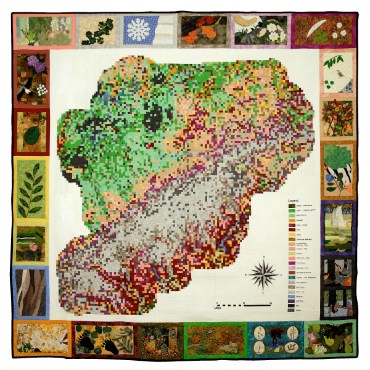
NPS photo
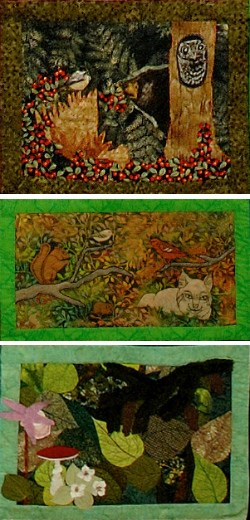
NPS Image
Spruce Forests
White and black spruce dig plant their roots into the sandy soil and dominate the densely-forested landscape, where the trees can be over 20 meters tall! Tamaracks and shrubs such as alders and willows grow wherever sunlight comes through. In the spring, male black-capped chickadees bring food back to the female and young and on the south side of the Alaska Range black bears roam the forests with their cubs.
In contrast to the dense spruce, trees in open spruce forests usually only grow around 7.5 meters tall. Frequently fires sweep across this landscape, but fire can help release seeds from black spruces’ semi-serotinous cones. Flashes of red feathers through the air offer clues of ruby-crowned kinglets and white winged crossbills, collecting insects and conifer seeds, respectively, in this more open forest. Red-backed voles and lynx can also be found wandering through the black spruce, labrador tea, and alders. Alluvial fans--or cone-shaped deposits of gravel--and outwash-floodplains created by rivers offer excellent conditions for this landcover type.
A stroll through the stunted spruce forest is certainly a feast for the nose. Plants like bog blueberry and labrador tea dominate this landscape, filling the air with fragrances. Bog Labrador tea leaves were even used by Native Americans across the country. It was also historically used to treat ailments such as asthma, diarrhea, pneumonia, sore throats, and headaches, depending on the region of the country. Black spruce trees Found at lower elevations north of the Alaska Range, soils are cold and poorly drained with abundant permafrost. Lady slipper orchids and dwarf dogwoods can be found scattered throughout the understory.
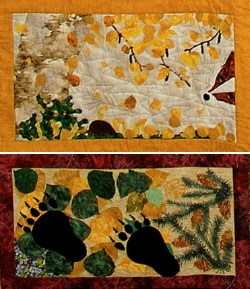
NPS Image
Aspen Forests
Winds will create a rustling sound as the air rushes through the leaves of paper birch and quaking aspen trees, which finally outnumber the spruce in this landcover type. Surprisingly, only about 1.6% of the park is classified as broadleaf, mainly occurring in floodplains. Small amounts of grasses and sedges can also be found here. What kinds of animals do you think live here?
What makes it easier for many types of trees to grow in a specific habitat? Moist soils are definitely a must, and make tree growth more successful. In deciduous-spruce forests, white spruce grow along with a mix of paper birch and balsam poplars. Because there are also many blueberries growing in this habitat, black bears can be seen ambling through the willows that also thrive here. This landcover type is most commonly found on the south side of the Alaska Range.
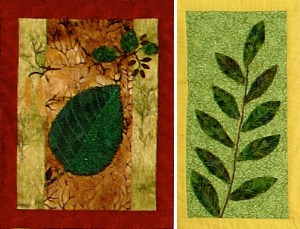
NPS Image
Tall Shrubs
Steep rocky slopes made up of glacial sediment can be found throughout the park, creating prime habitat for various species of alder shrubs. In fact, over ¾ of the plants found in this landcover type are alder species! This genus (Alnus spp.) is special because it has the ability to fixate nitrogen. The alder plant forms a team with bacteria in the soil--called a symbiotic relationship--in order to take nitrogen from the ground instead of the air. This allows alders to grow in less fertile habitats because they are able to take up more nutrients from the soil. Green false hellebore and devil’s club are two other plants that can be found in the understory here.
Six species of willows dominate the overstory of willow landscapes, including the Alaska willow. Willows are insect- (often bumblebee-) pollinated and produce a large amount of seeds which are dispersed by wind and water. This landcover type is most frequently found around mid-elevation alluvial stream deposits and near small streams, making dispersal of seeds easy. Grasses and sedges such as cow parsnip and bluejoint grass can also be found here.
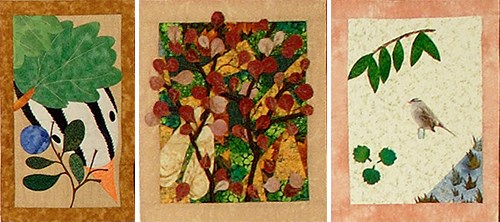
NPS Image
Low Shrubs
The white-crowned sparrow is well-known for whistling and buzzing through the low vegetation. Though it spends its summer in northern habitats such as Alaska, these sparrows migrate south for the winter. They are also known for having different song “dialects” based on where they are from. This landscape is almost completely covered in shrubs, most of which American dwarf birch. Blueberry patches can be scattered among the shrubs.
Another low shrub landcover is mixed with ericaceous willow and sits below the alpine zone and above the boreal forest, most commonly on slopes of foothills and broad valleys. Dwarf birch is the most common plant here, along with crowberries and labrador tea, which are pictured in the quilt. Upland sandpipers and moose will also make appearances as they scavenge for berries and food.
The last type of low shrub landcover is mixed with sedges. Tussocks are areas of raised solid ground in bogs that are held together by root systems, and are common here. This indicates that soils also have more moisture in this landcover type. Settled between the alpine zone and boreal forests, shrubs are around 20 to 150 cm tall. Leatherleaf is commonly found here, and the white-crowned sparrow can be seen foraging for insects and seeds on the ground and from branches of the shrubs.
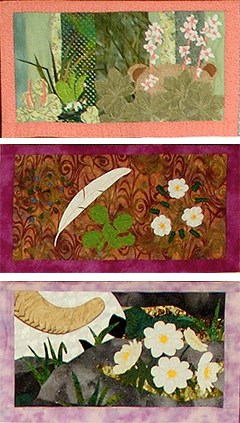
NPS Image
Dwarf Shrub
Grizzly bears love to frequent these shrub-covered landscapes for bearflowers, also known as Richardson’s brookfoam (Boykinia richardsonii). It can be easily identified by its straight spike of white-pink flowers and kidney-shaped leaves covered in a waxy layer--no other plant in the park has this combination of characteristics. Bell heather also grows here. This environment can often be found on mountain ridges and slopes on the southern side of the Alaska range.
Dwarf shrubs less than 20 cm tall blanket the mountain slopes and high valley floors. Around a quarter of the ground is bare rock. Soils are thin, and mountain avens and blueberries poke up from between the rocks. Ptarmigan can also be seen foraging for food here.
Dwarf shrub rock is the highest in elevation. Dall sheep thrive in this rocky habitat that sits in the clouds. Rocks become more prominent in this landcover that is found on mountain ridges, sandbars, and alluvial fans. Small mountain avens inhabit the thin, dry layer of soil and Dall sheep feed on them as they climb through.
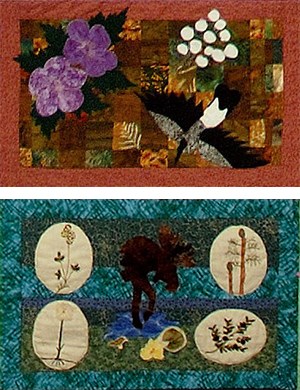
NPS Photo
Wetland Plants
Because there is more moisture here, meadows are full of productive forbs--or flowering herbs--such as hellebore, Scots lovage, and lady ferns. Wild geranium and cotton grass can also be found here. If you watch carefully, you may see a northern wheatear perched a few feet off of the ground on a shrub, scouting for food and diving once it sees suitable prey. Wheatears tuck their nests into the ground under large rocks or in abandoned burrows from other animals, constructing them out grass, twigs, moss, and lichens.
Moose and beavers enjoy this habitat full of standing water known as wet herbaceous. There is also plenty of emergent vegetation, or plants that are partially in the water. Cotton grass, common horsetail, and water lilies all thrive in the moist environment. Can you think of any habitats near the park entrance that would fall into this category?
As the least common landcover type, aquatic herbaceous habitats occur in less than 0.01% of Denali. Bearberry is the most notable plant here, along with the pygmy waterlily and the nuphar, which float in the permanent water. Though there are fish in Wonder Lake, most of the parks aquatic habitat is not suitable for fish due to the amount of glacial silt in the water. Next time you are near a river, look at it’s contents. Does it look like it’s carrying a lot of sediments, or is it fairly clear?
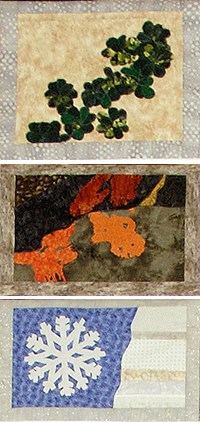
NPS Image
Into the Rocky, Snowy Slopes
At high elevations, plants begin to grow fewer and farther in between. This landcover type has plants scattered over bedrock, sandbars, alluvial fans, and debris-covered glaciers. Mountain avens are dominant in this environment that is often found in the high mountains and valleys of the Alaska range. Even though mountain avens look like a forb, they are actually small shrubs with woody stems. If it is living in a good habitat, it can live up to 100 years! Paleoecologists around North America have also found fossils of plants from the mountain aven genus, which can help them analyze past climate shifts based on where the flower was growing. They are also capable of heliotropism, which means the flowers face different directions throughout the day in order to follow the sun. This helps them maximize the amount of sunlight that they get each day.
Nearly 10% of Denali National Park and Preserve is covered by bare ground, usually found on mountain peaks, rock outcrops, and river outwash plains. Lichens--a mutual partnership of algae and fungi--are the dominant form of life because of its ability to survive extreme conditions.
Snowfields, glaciers, and late-lying snow are all categorized under “snow-ice”. As the least habitable landcover type in the park, snow-ice classification can reach up to 6,188m in elevation, dominating the Alaska range with a whopping 15.5% coverage of Denali National Park and Preserve.
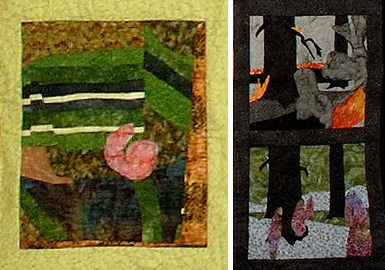
NPS Image
Peatlands and Burn Areas
Peatlands are classified into two categories: fens, which are nutrient rich, and bogs, which are nutrient poor. They usually occur in lowland former lake basins next to forests. Some plants that grow here are emergent, meaning they are partially in the water. Bluejoint, bottle sedge, and fewflower spikerush are all good examples of this. Shrubs grow here, too, with bog-mertle and dwarf birch being most common. Orchids bloom in bright colors in contrast to the colors of the murky waters and yellow vegetation.
Burn areas most commonly occur in spruce-dominated environments in the northwestern part of the park, either as level landscapes or rolling hills. But wildfires aren’t always a bad thing--cones that fall from black spruce trees are better released under the heat of fire, and fire clears the understory so that black and white spruce trees have better access to a fertile seedbed.
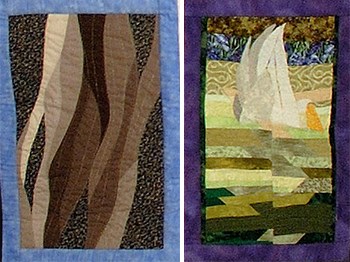
NPS Image
Water in Denali
There are two types of water landcover types in the park: silty and clear. Parts of Lake Minchumina are some of the only places in the park where silty water can be found. It is also common in cook-inlet braided flood plains and stream terraces. Water has high to moderate levels of glacial silt and debris.
Water that has little to no sediment makes up most of the lakes and ponds in Denali, which is around 1% of the total land coverage. Where do you think this clear water is coming from?
Last updated: March 18, 2022
